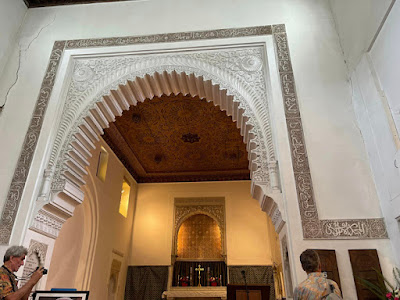 |
| One of the Freak Alley Gallery murals in downtown Boise, Idaho |
My friend Caroline Hatton, a children’s writer and frequent contributor to this blog, enjoyed taking the photos in this post in October 2022.
 |
| Mural on the back of the West Elm store, Boise, Idaho |
While traveling by car through Boise, Idaho, my husband and I jumped at the chance to see the FreakAlley Gallery, a collection of diverse outdoor murals painted by many artists over twenty years, so far. The gallery is in the alley that goes from 8th to 9th Street through the city block between Idaho and Bannock Streets in downtown Boise.
 |
At 8:30 a.m. on a sunny October Friday, the streets were still in the deep shade of buildings, car traffic was light (compared to L.A. traffic… maybe traffic is incomparably lighter most everywhere else?), and only a few pedestrians walked along the sidewalks carrying cardboard cups from coffee shops. Finding a parking spot at a meter was not difficult.
 |
 |
I like blues and black and white.
Freak Alley was covered with more paintings than I expected, not only on the back walls of buildings, but also on side walls and doors and doorways. I looked for interesting photos to take or works I liked, feeling a bit overwhelmed by how much there was to see.
 |
My favorite: cats in kimonos.
Most of the artworks were big and loud and weird, with few exceptions such as the cats in Japanese kimonos inside one doorway. You can see more photos at the above link, including by clicking on the down-arrow on that web page, then on 2019. The Freak Alley Gallery is a testament to the ongoing community support that makes it possible.
 |
Some filming in progress.
I was glad I visited before 9 a.m. on an October Friday, when the trash containers smells had barely begun to develop in the mid-50s F (~13 C) temperature. We were alone in the alley except for two delivery truck drivers unloading restaurant supplies, and a cameraman on a hoverboard filming his subject.
Before the parking meter expired, we strolled around the Capitol and past the City Hall, and sipped lattes on a coffee shop patio on one of the two pedestrian blocks lined with restaurants, closed at that time, as were gift shops and art galleries. Then we drove a few blocks to the Basque Block a charming cluster of Basque buildings and businesses with a community center.
 |
| From left: explorer and merchant ship; farmhouse; fragment of Picasso’s Guernica; historic tree, buildings, dance teacher, accordion player; Boise cathedral; weightlifting contestant; sheep camp |
At the Basque Market shop and eatery, we admired cheeses and sausages, and chatted with the chef who was cooking the Friday seafood and chorizo paella on the outdoor patio. Some other time, we might visit the Basque Museum to learn how some 16,000 Basques ended up living in Boise now. This time, I just took a photo of the very well done Basque Mural.

























